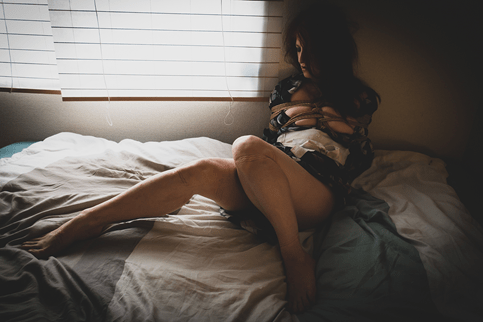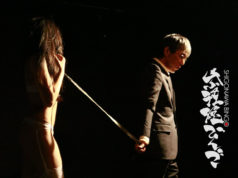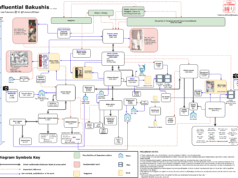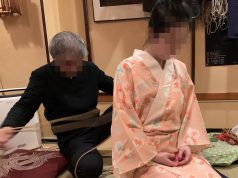This article was originally a webinar I delivered for Studio Kokoro (UK) in 2021.
I have been thinking more and more about the subject and decided to put thoughts and feelings in words.
I am today 49 years old, I am doing Kinbaku since 2011, and at a professional level since 2013.
This meant, in the years before Pandemic, being tied at least 600 times per year, mostly every weekend.
In my journey, I made lots of changes.
When I started, Kinbaku was mainly for me a way to channel the darkest part of myself. An activity that was never easy. My best ways to express myself have always been arts or physical expression, like poetry or dance. They always allowed me to access a language to open up my feelings through a non verbal (rational) and primal mean. But as a former dancer, I was looking a lot for the physical challenge that ropes could provide. With time, and experience, and ageing, I progressively passed from showing my body, to showing my soul.
From showing strength, to showing vulnerability.
From a “me” centric to a “dynamic” centric approach: my rigger is not a rope ATM that is required or forced to provide a rope experience. It’s something you decide to do together, and only if you both want it.
In my opinion, Semenawa is particularly suited to those qualities they you potentially find more easily in a mature heart.
First of all because Semenawa, in the words of Natasha Nawataneko, “implies INTENSITY. Emotional as well as physical… It is not necessarily extreme back bend. But it is about going out of your personal comfort zone, coming close to your limits, dancing on the edge… On your own edge, of course. It is always personal and unique, this space. We all have different limits… But just performing even an extreme tie is not yet enough. You can hang upside down on one ankle, you can be completely exposed naked, but never go into semenawa space. I believe it is also about INTENTION”.
Riccardo Wildties says that “Semenawa starts when you want to get down. When you are passing the threshold of “what is enough”. It is in the moment in which an ordinary bondage scene would stop that torture starts. Semenawa is giving “more than enough”…”.
Again in the words of Wildties “Tormenting rope is made for souls that have that sadness within, that turmoil, that need for surrender regardless of who ties and who is tied. It’s not about sadism and masochism, it’s about a pilgrimage, it’s about climbing a mountain together, it’s about the journey not the destination”
As you can read in these different perspectives, main key features of Semenawa seem to be a certain degree of torment, intensity, surrender, sense of progression, crescendo and timing that are completely opposite to quick satisfaction, fun and impatience.
Features that require patience, determination, depth, dedication, and courage to wait.
If we take as a reference the Erikson’s stages of psychosocial development, we start to ask ourselves the more existential (and introspective questions, like Who am I? Who can I be? Can I love? Can I make my life count? Is it okay to have been me?) from the adulthood, not before.
Even in the rope experience I think both as models and riggers we go through different stages of growth. In the beginning, we want it all and now, we want to have fun, to risk, to run and to rush. Maturity though comes with experience and building context around the pure skill and the pure first time experiences. It takes time. It takes depth.
And how do you develop depth? I will try to describe what helped me, personally.
Developing an internal focus vs external focus (feeling vs appearing).
I evolved from a need to challenge myself, to see what my body was capable of, to challenge myself to understand what I had inside, that made my rope experience much more special.
Refining gestures and postures.
The fact that thanks to teaching I had to go through the same tie again and again, allowed me to understand myself and these feelings always better, because I had more time to process, more chances to experience the same tie in different moods and conditions. Like the bar for the dancer: every day you have to repeat, slow down, enjoy, catch the beauty of the movement instead of simply focusing on the final result.
At the same time, when tying in private, we tie only when we want it, or when we feel we have something to put in it, and this implies a more dense and full-bodied experience.
Increasing awareness.
I started improving the level of knowledge and understanding of the meaning of what we do: thanks to the study of the Japanese culture & language, listening to Miho Ikeda’ stories, observing Sugiura Norio at work, developing a deeper appreciation of Aesthetics.
Miho Ikeda, Sugiura Norio’s Muse, said to us during a workshop in Copenhagen few years ago, when she was asked to give advices to Western models on how to live a better rope experience in a more “Japanese” spirit:
Don’t try to look “beautiful”. Rather, ask yourself what and how much you’re ready to give in ropes.
As anticipated before, in the beginning ropes were a lot “physical”, a challenge with myself and with my body.
With ageing and maturity, of course my body changed too. While I am still very lucky and can benefit from years and years of physical activity almost to a professional level and maintain good habits, of course muscles’ tone, bones, tissues, body reactions change.
More pointy sheen bones made less bearable a futomomo for example. Decrease of stamina makes me more easily tired. I had to start stretching more, especially for ties that were challenging to me (like backbends).
But actually, stretching more made me more flexible than when I was younger, and caring for myself allowed me to become more aware of my body and to prevent risks and injuries.
So my rope experience increasingly focused my attention more on what was valuable for me, not only physically, or I would say, beyond what my body could do.
I remember once I commented on a Sugiura Norio’s picture showing a lady sitting, tied in a simple TK and shot from the back, showing only a naked shoulder out of a very beautiful Kimono, the head slightly turned on the side.
I commented that it was very sensual.
He replied “Korezo jukujo no irokodesu”: This is the sex appeal of a mature woman.
Implying simplicity, but at the same time, intensity.
So what can maturity bring to our Semenawa experience?
To me, it meant no more struggling for super athletic ties, and enjoy with much less. Becoming more receptive, and appreciating more the power of timing and progression. It’s like the difference between pounding one beer after another or sipping a very good wine.
And as I feel less the need to show off and look beautiful, this allows me to connect with the more intimate part of myself and being able to let go even more, and allow myself to experience a wider range of feelings. This is true even for Kinbaku photography, I care less about pure wow factor of the tie, mere physical beauty and appearance, and privilege more details, and lines that tell a story. I feel that darkness can be seen by the crease in a neck and the tension in the hands…
So what I would suggest to models to give themselves the opportunity to go in that direction, would be first of all to not fall into the trap of thinking “I want to do these things, no matter possible limitations” and thinking instead “what things can I do that exalt me, my body, and my way of experiencing ropes?”.
And instead of perceiving your body as an enemy (the things I cannot do), accept it and enjoy it as a new challenge (how can I adapt and turn into positive what could appear as a conditioning?). Be curious and discover your NEW potential. We all become even better with age at some things. For example, I became better in processing my own experience, and detecting good pain from bad pain, so I can let go more easily and listen to my body with patience, I rarely experience panic.
I would like to close with a short extract from a dance Author, Priscilla Regalado, that wrote a piece about aging for dancers.
“Aging as a dancer can pose many challenges, as well as opportunities. The reality is that our bodies age and change, making it difficult if not impossible to continue dancing as we once did. We now have a chance to slow down and pay attention differently. Through the wisdom of our age, creative expression, depth of understanding the human spirit and the vicissitudes of life, our dancing changes to offer another level of experience.”
A mature heart in Semenawa can offer a pair of glasses that filter reality from a completely new perspective,giving a richness and complexity to our way of experiencing ropes that is powerful and unparalleled.







